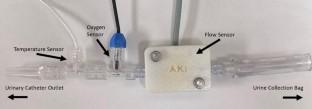Journal of Clinical Monitoring and Computing ( IF 2.2 ) Pub Date : 2022-06-01 , DOI: 10.1007/s10877-022-00843-z Lars R Lofgren 1, 2 , Natalie A Silverton 1 , Kai Kuck 1 , Isaac E Hall 3

|
Purpose
Urine oxygen partial pressure (PuO2) may be useful for assessing acute kidney injury (AKI) risk. The primary purpose of this study was to quantify the ability of a novel urinary oxygen monitoring system to make real-time PuO2 measurements intraoperatively which depends on adequate urine flow. We hypothesized that PuO2 data could be acquired with enough temporal resolution to provide real-time information in both AKI and non-AKI patients.
Methods
PuO2 and urine flow were analyzed in 86 cardiac surgery patients. PuO2 data associated with low (< 0.5 ml/kg/hr) or retrograde urine flow were discarded. Patients were excluded if > 70% of their data were discarded during the respective periods, i.e., during cardiopulmonary bypass (CPB), before CPB (pre-CPB), and after CPB (post-CPB). The length of intervals of discarded data were recorded for each patient. The median length of intervals of discarded data were compared between AKI and non-AKI patients and between surgical periods.
Results
There were more valid PuO2 data in CPB and post-CPB periods compared to the pre-CPB period (81% and 90% vs. 31% of patients included, respectively; p < 0.001 and p < 0.001). Most intervals of discarded data were < 3 minutes during CPB (96%) and post-CPB (98%). The median length was < 25 s during all periods and there was no significant difference in the group median length of discarded data intervals for AKI and non-AKI patients.
Conclusions
PuO2 measurements were acquired with enough temporal resolution to demonstrate real-time PuO2 monitoring during CPB and the post-CPB period.
ClinicalTrials.gov Identifier:
NCT03335865, First Posted Date: Nov. 8th, 2017.
中文翻译:

尿流量对心脏手术中尿氧分压监测的影响
目的
尿氧分压 (PuO 2 ) 可能有助于评估急性肾损伤 (AKI) 风险。本研究的主要目的是量化新型尿氧监测系统在术中进行实时 PuO 2测量的能力,这取决于足够的尿流量。我们假设可以通过足够的时间分辨率获取 PuO 2数据,以提供 AKI 和非 AKI 患者的实时信息。
方法
分析了 86 名心脏手术患者的PuO 2和尿流。与低 (< 0.5 ml/kg/hr) 或逆行尿流量相关的PuO 2数据被丢弃。如果在相应时期(即体外循环 (CPB) 期间、CPB 前(CPB 前)和 CPB 后(CPB 后))丢弃的数据 > 70%,则患者被排除在外。记录每位患者丢弃数据的间隔长度。比较 AKI 和非 AKI 患者以及手术期间的丢弃数据间隔的中位长度。
结果
与 CPB 前相比,CPB 和 CPB 后期间有更多有效的 PuO 2 数据(分别包括 81% 和 90% 与 31% 的患者;p < 0.001 和 p < 0.001 )。在 CPB (96%) 和 CPB 后 (98%) 期间,大多数丢弃数据的间隔小于 3 分钟。所有时期的中位长度均小于 25 秒,并且 AKI 和非 AKI 患者的丢弃数据间隔的组中位长度没有显着差异。
结论
PuO 2测量值以足够的时间分辨率获得,以证明在 CPB 期间和 CPB 后期间的实时 PuO 2监测。
ClinicalTrials.gov 标识符:
NCT03335865,首次发布日期:2017 年 11 月 8 日。


























 京公网安备 11010802027423号
京公网安备 11010802027423号